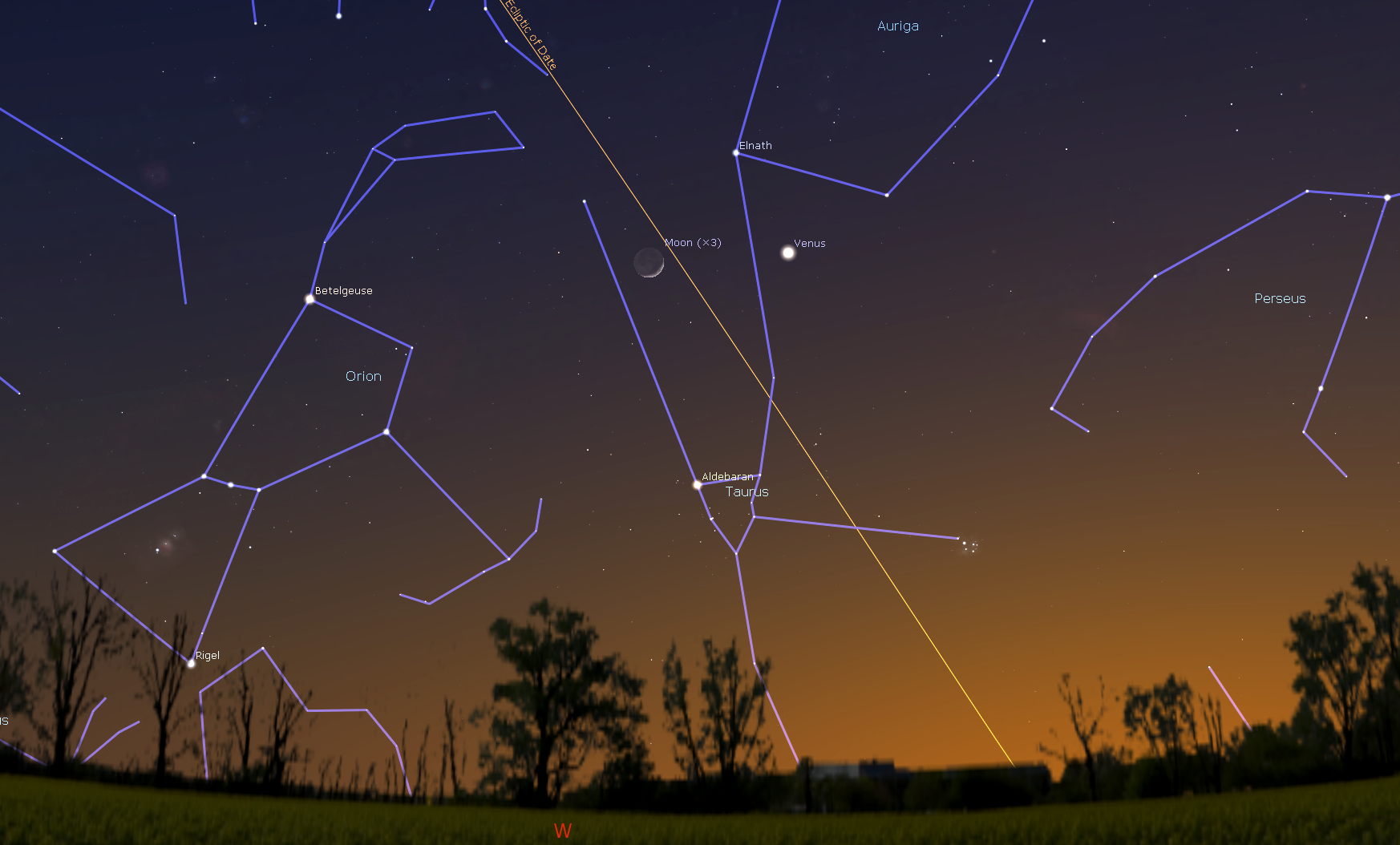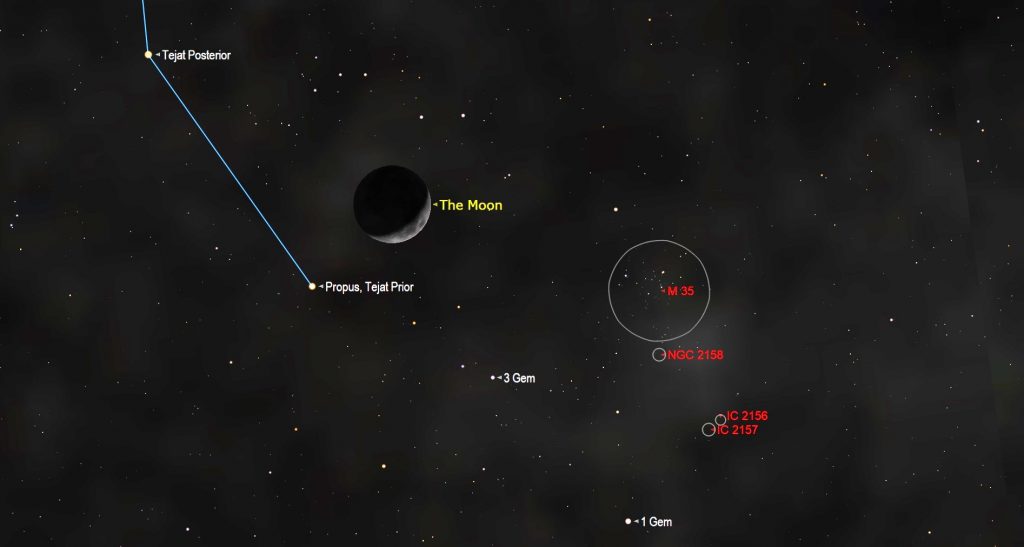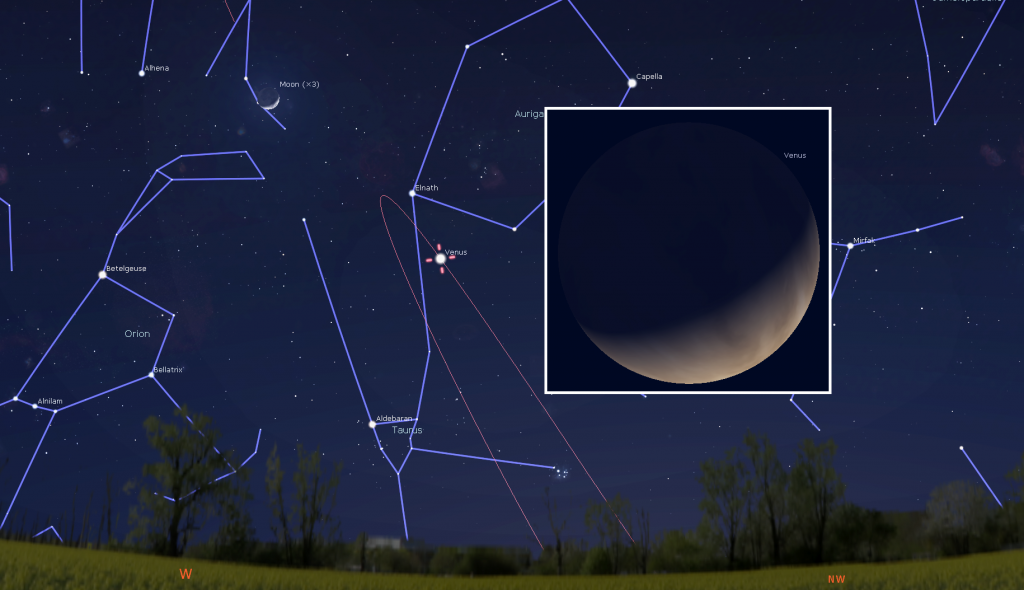Venus at Biggest Brightness, Love Letters on the Moon, a Second First Quarter, and Prominent Pre-dawn Planets!

On Sunday evening, April 26, the young crescent moon will sit beside the bright planet Venus in the western sky after sunset, as shown here at 9 pm local time. The sight will make a lovely photo opportunity.
Hello, Moon and Venus Lovers!
Here are your Astronomy Skylights for the week of April 26th, 2020 by Chris Vaughan. Feel free to pass this along to your friends and send me your comments, questions, and suggested topics. You can also follow me on Twitter as @astrogeoguy! Unless otherwise noted, all times are expressed in Eastern Time. To subscribe to these emails please click this MailChimp link.
I can bring my Digital Starlab portable inflatable planetarium to your school or other daytime or evening event, or teach a session online. Contact me through AstroGeo.ca, and we’ll tour the Universe or the Earth’s interior together!
Early this week, the moon will re-appear in the post-sunset western sky. While there, it will pose with bright Venus, which reaches maximum brightness this week. For the rest of the week the moon will be a nice after-dinner target for lunar lovers all over the world. On Wednesday night you can hunt for letter-shaped features on it and Thursday brings the second first quarter moon of April. Three bright planets continue to dance along the ecliptic before dawn. Here are your Skylights!
The Moon and Planets
This is the week of the lunar month when skywatchers all over the world will be treated to views of our natural satellite in the evening sky. In the western sky after dusk tonight (Sunday), the slim, waxing crescent moon will make a pretty sight when it sits a palm’s width to the left (or 6 degrees to the celestial south) of very bright Venus. The moon and the planet will make a pretty sight in binoculars and a spectacular widefield photograph when composed with some foreground trees or city skylines. Meanwhile, commencing at about 11:40 GMT on April 26, observers in parts of China, Southeast Asia, Philippines, and Southern Japan can see the crescent moon move in front of (or occult) the large main belt asteroid Vesta.

On Monday night, the moon will climb to sit higher than Venus. At that time the moon will be sitting near three medium-bright stars named Tejat Posterior, Propus (aka Tejat Prior), and 1 Geminorum. They form the feet of Castor, Gemini’s more westerly twin. The term “Tejat” refers to the foot, and “prior” rises before “posterior”. Using binoculars, look for a tight cluster of stars sitting less than two finger widths to the right (or 1.75 degrees to the northwest) of the moon. That’s the open star cluster known as Messier 35, M35, or even more appropriately, the Shoe-Buckle Cluster. The cluster and the moon will be close enough to fit together in the field of view of binoculars – but the cluster will be easier to see if you keep the bright moon just outside your binoculars’ field of view.
Also on Monday evening, Venus will achieve its “greatest illuminated extent” for the current lengthy evening apparition. Venus’ orbit is currently bringing the planet close to Earth. That terminology describes the optimum combination of the approaching planet’s apparent disk size (38 arc-seconds) and its illuminated phase. In simple terms, Venus will shine at a spectacular maximum brightness of magnitude –4.73 and its 27% illuminated crescent phase will be visible in any telescope or spotting scope, good binoculars – or even to very sharp, unaided eyes.
Venus will be setting in the west at about midnight in your local time zone this week. Viewed through a telescope, the planet will show a nice, large, crescent shape. If you want to see Venus’ less-than-fully-illuminated disk, aim your telescope at the planet as soon as you can pick it out of the darkening sky. In a twilit sky, Venus’ out-of-round shape will be more apparent. And, when Venus is higher in the sky you’ll be viewing the planet more clearly – through less of Earth’s distorting atmosphere.

For the rest of the week, the moon will slide east in its orbit, causing it to set later at night and grow fuller in phase. These are the best nights to view the moon in binoculars and backyard telescopes. Along the terminator, the pole-to-pole boundary that divides the moon’s lit and dark hemispheres, the sun is rising over the moon. That nearly horizontal sunlight casts long, deep black shadows from every crater rim, mountain, ridge, hill, and bump. The moon will be rising in the daytime and posing for your viewing all evening long – ideal for youngsters with early bedtimes. And, even better, new zones are highlighted every night as the moon waxes.
On Wednesday night, you can look for the Lunar X while the moon crosses the dim stars of Cancer (the Crab). Read the section below for Lunar X details. Observers in Asia will see the moon skim past the northern edge of the large open star cluster known as the Beehive or Messier 44. Those of us in the Americas will see the moon sitting about a palm’s width away from the cluster. The moon passes close to, or through, this cluster frequently because the Beehive is located only 1 degree north of the ecliptic.
On Thursday afternoon, the moon will officially reach its first quarter phase, when the relative positions of the Earth, sun, and moon cause us to see the moon half illuminated – on its western (right-hand) side. When a lunar phase occurs on the first day of a calendar month, it can repeat at month-end – so we get the second first quarter phase in April.

On Friday, look for the gibbous (i.e., more than half illuminated) moon sitting near the bright, white star Regulus. That star marks the heart of Leo (the Lion). For the rest of the weekend, the nearly full moon will traverse the rest of the lion and then enter the modest stars of Virgo (the Maiden).
The southeastern pre-dawn sky continues to host the three bright planets Jupiter, Saturn, and Mars. They form a line more than two fist diameters in length along the ecliptic. Jupiter will lead the parade when it rises first at about 2 am local time. Yellowish Saturn will rise about 20 minutes later, and then Mars will round out the trio – rising at about 3:30 am. All three planets will remain visible until almost sunrise – with brighter Jupiter hanging on a bit longer than the other two. During the week, Mars will continue to increase its distance from the two gas giant planets.
In the Eastern time zone, Jupiter’s Great Red Spot will be crossing the planet’s disk on Tuesday morning and Friday morning. Jupiter’s moon Io will cast its small, round, black shadow on Jupiter on Wednesday morning before 4 am EDT. On Sunday, May 3 from 6:35 to 10:00 GMT (or 2:25 to 6 am EDT) observers in the Americas with good quality telescopes can watch Callisto’s shadow cross Jupiter, accompanied by the Great Red Spot!

For those keeping score, Uranus, Neptune, and Mercury are all in the pre-dawn eastern sky – but they are too close to the sun, or too low in the sky, to observe easily right now.
An X on the Moon, and More
Several times a year, for a few hours near the moon’s first quarter phase, a feature on the moon called the Lunar X becomes visible in strong binoculars and backyard telescopes. When the rims of the craters Purbach, la Caille, and Blanchinus are illuminated from a particular angle of sunlight, they form a small, but very obvious X-shape. The phenomenon called is pareidolia – the tendency of the human mind to see familiar objects when looking at random patterns. The Lunar X is located just to the right (or lunar east) of the pole-to-pole terminator boundary that separates the lit and dark hemispheres on the moon. The X is about one third of the way up from the southern pole of the Moon, at lunar coordinates 2° East, 24° South. The prominent round crater Werner sits to the lower right of the X.

Late in the evening of Wednesday, April 29, the Lunar X is predicted to peak in intensity at 9:45 pm EDT (That’s 01:45 Greenwich Mean Time on Thursday, Apr 30) – but the phenomenon will be visible for approximately two hours before and after that time. This event will be visible across large portions of the Earth – wherever the moon is shining in a dark sky during that time window. To know when to look, simply adjust for your difference from the Greenwich Time zone. For the Great Lakes region, the Moon will be positioned partway up the western sky.
At the same time, you can look for the Lunar V and the Lunar L. The “V” is produced by the small crater Ukert when combined with some ridges to the east and west of it. It is located a short distance above the moon’s equator at lunar coordinates 1.5° East, 8° North. For a further challenge, see if you can see the letter “L” down near the moon’s southern pole. Its position is to the southwest of three prominent and adjoining craters named Licetus, Cuvier, and Heraclitus, which combine to form a Mickey Mouse’s head shape. Some people claim they can see a letter-E on the moon during the Lunar X period, too. Then, by picking a round crater along the terminator to serve as the “O”, you can spell L-O-V-E! Let me know if you see them.
It’s Spring Galaxy Time!
This week’s evening moon will spoil the sky for galaxy hunting, but the moon will get out of our way again after mid-May. If you missed last week’s information about spring galaxy hunting, it’s here.
Public Astro-Themed Events
Due to the COVID-19 virus, in-person public star parties and lectures have been cancelled or postponed for the moment. Here are some Internet-based astro-themed activities.
My Insider’s Guide to the Galaxy live daytime astronomy broadcasts are geared towards families, in partnership with the Royal Astronomical Society of Canada. They’ll continue on Tuesday, April 28 at 3:30 pm EDT. I hope you’ll join me and my co-host Jenna Hinds, , the terrific Youth Coordinator at RASC National. Future topics and the Zoom link to sign up are all here. You can also watch the sessions on the RASC’s YouTube channel in real time, or later on. The past sessions are all posted there, too.
On Wednesday evening at 8 pm, the RASC Toronto Centre will broadcast their Recreational Astronomy Night meeting on their YouTube channel. Topics include the Sky This Month, delivered by me, a talk about Johannes Kepler, and more. Details are here.
Many astronomers are running broadcasts of the views through cameras attached to their telescopes while they describe the item and take questions. A search for the terms “star party” on YouTube and FaceBook should let you find live or pre-recorded sessions.
The Canadian organization Discover the Universe is offering astronomy broadcasts for students called Astro at Home. Their website is here, and their YouTube channel is here.
On many evenings, the University of Toronto’s Dunlap Institute is delivering live broadcasts. The streams can be watched live, or later on their YouTube channel here.
The Perimeter Institute in Waterloo, Ontario has a library of videos from their past public lectures. Their Lectures on Demand page is here.
Keep looking up, and enjoy the sky when you do. I love questions and requests. Send me some!